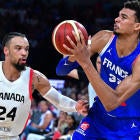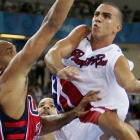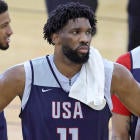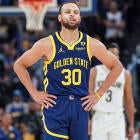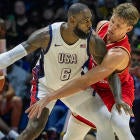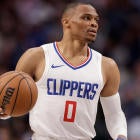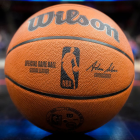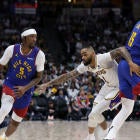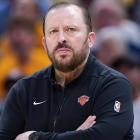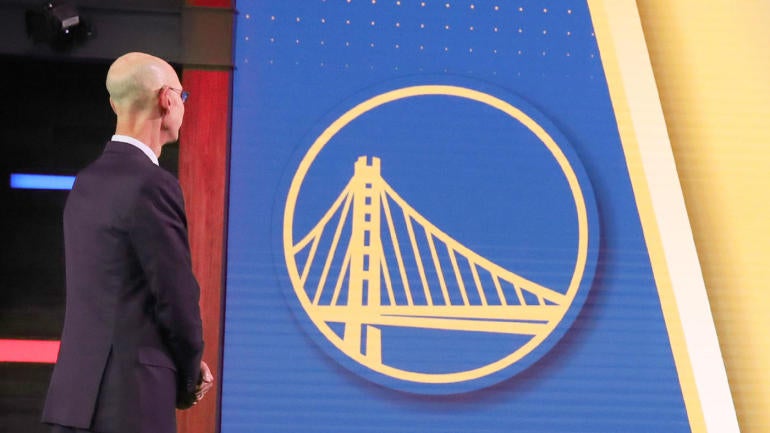
The Golden State Warriors have always been rewarded for their ambition. The basketball world dismissed the idea that they could sign Kevin Durant … until they did it. They acquired D'Angelo Russell purely for the purpose of later trading him, and in the process managed to acquire not only a future lottery pick from Minnesota, but a valuable reclamation project in Andrew Wiggins as well. The Warriors routinely take risks in the name of maximizing their possible reward. It has largely worked out for them. The Warriors have never let "good" become the enemy of "great."
That appears to be their plan heading into the 2021 NBA Draft, in which the Warriors have the Nos. 7 and 14 overall selections. ESPN's Adrian Wojnarowski recently reported that Golden State has zeroed in on two options leading into the NBA Draft: trade all of its young assets for Bradley Beal, or hold onto them in the hopes that a star of his caliber may become available to them down the line. Most of the other reporting on their plans seems to support that notion. No other major trade targets are known at this point. Bleacher Report's Jonathan Wasserman reported that the Warriors turned down an offer of the Nos. 19 and 21 overall picks for No. 14. General manager Bob Myers seemed to hint at the idea of one move that might have helped Golden State acquire a Beal-caliber player: trading up, though he later revealed that he expected the price of doing so to be too great.
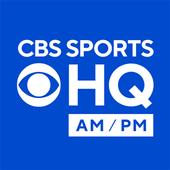
CBS Sports HQ Newsletter
Your Ultimate Guide to Every Day in Sports
We bring sports news that matters to your inbox, to help you stay informed and get a winning edge.
Thanks for signing up!
Keep an eye on your inbox.
Sorry!
There was an error processing your subscription.
"I think it's going to be tough," Myers told reporters. "Based on conversations, I think it's going to be hard. And I don't say that specific to the Warriors. I just think that's probably the league. I think it's going to be tough."
Trading up tends to be tough. Making any trade in which you acquire the single-best asset tends to be tough. That is what trading for a star almost always entails, but that doesn't mean doing so is necessarily in a team's best interest. Plenty of executives have fleeced peers by turning a single player into several valuable pieces. Golden State already has a superstar trio in Stephen Curry, Klay Thompson and Draymond Green that won the 2015 championship without Durant. Adding more stars is rarely a bad thing, but more than anything, Golden State just needs good, NBA players.
The Warriors had very few of those last season, and it showed. It's not a coincidence that Curry needed to take a career-high 21.7 shots per game last season. Most metrics suggest that Green was his only teammate that was firmly starting-caliber. FiveThirtyEight's Wins Above Replacement metric pegged Curry as being worth 10.8 WAR and Green 7.5. No other player on the roster reached three. Only three full-time Warriors had positive Box Plus-Minus numbers: Curry, Green and Juan Toscano-Anderson. When Curry left the floor last season, the Warriors got 10.2 points per 100 possessions worse, and lest you believe that was an anomaly due to Thompson's injury, they declined by at least 12.7 points per 100 possessions without Curry in each of the Durant years.
This has been Golden State's problem for the past half-decade. The Warriors are extremely top-heavy. That was fine when being top-heavy meant having two of the best 15 or so players in NBA history alongside two other All-Stars, but normal teams need some amount of depth to support their best players. Due to a combination of its expensive roster, assets lost supporting the dynasty and years of poor player development, Golden State's supporting cast largely consisted of young draft picks or recent G League alums trying to make their mark in the NBA last season. The 2020-21 Warriors devoted almost 30 percent of their minutes, 5,068 out of a possible 17,305, to players who had been in the G League at some point in the past three seasons. Putting aside the talent deficiency that creates, such youth and inexperience just aren't going to win at the NBA level. Myers even addressed this.
"I think one idea is to get a little older," Myers said in a call with season-ticket holders. "Not super old but to add some guys that are a little bit more veteran and shore things up there."
A trade partner exists that is capable of doing just that. The Memphis Grizzlies have spent years drafting older college players who lacked apparent upside because they trusted that doing so would yield the sort of valuable NBA role players that any contender needs. The plan almost worked too well. The Grizzlies have gluts at almost every position. There is simply no way they can afford to pay Grayson Allen, Desmond Bane and De'Anthony Melton at shooting guard. They already traded away Jonas Valanciunas in part because extending him made little sense for a roster with Jaren Jackson, Xavier Tillman and Brandon Clarke. Depth is the last thing Memphis needs. The Grizzlies want more high-end talent.
They're willing to pay for it, too. They absorbed the toxic contracts of Steven Adams and Eric Bledsoe just to get from No. 17 in the NBA Draft to No. 10. The Ringer's Kevin O'Connor reported that they aren't done. They want to move up again, and Jonathan Kuminga and James Bouknight are possible targets. The Warriors, nesting at No. 7, can accommodate them.
Crafting a trade would be remarkably simple. Most of those role players have fairly low salaries as recent draft picks, so they wouldn't drastically increase Golden State's already exorbitant tax bill. Golden State could demand some combination of Allen, Bane, Melton, Clarke and Tillman in exchange for swapping picks with the Grizzlies. Walking away with one of them would be a win for the desperately thin Warriors. Two would be a home run, and if the Warriors want to get off the $5.2 million owed to Kevon Looney through his player option, they could always include him in the deal as matching salary.
Which players Golden State would actually be able to extract is less clear, but it hardly matters. Bane is far more valuable than Allen just by virtue of the two extra years of cheap team control he has on his rookie deal, for example, but Allen has hovered around 40 percent from behind the arc over the past two seasons and proved against these very Warriors that he is comfortable playing in big games. Ask the 2019 Warriors how valuable that is. With Durant out, Warriors not named Curry or Thompson shot only 31 percent from behind the arc in the Finals loss to the Toronto Raptors. One deadeye shooter may have been enough to swing that series. Even if he stays for only one year before becoming a restricted free agent, a win-now Golden State team will have gotten a far better role player than it could afford with the taxpayer mid-level exception through this trade. If the Warriors get two of them and still use that exception, they'd have gone a long way toward solving their bench woes.
If they're feeling particularly greedy, the Warriors could even ask for their own 2024 first-round pick back alongside a player. They sent that selection to the Grizzlies when they needed to dump Andre Iguodala's contract in 2019. Getting that pick back would free the Warriors up to trade more of their own future draft capital elsewhere because that pick currently has protections that might not allow it to convey until 2026, thus locking several years worth of first-round picks out of trades, thanks to the Stepien Rule. That pick has quite a bit of value. Curry will be at least 36 when it conveys, and teams dealing stars down the line would likely be interested in it. But the Grizzlies wants to move up badly enough, they would likely surrender it.
That is the advantage of being the team giving up the best asset in a deal. The other party typically wants that single, high-upside piece badly enough to pay an exorbitant price to get him. If you need depth, you'll almost always be able to find it by downgrading somewhere. In this case, that downgrade would be minimal. The Warriors would be dropping only three spots. The quality of prospects available to them is unlikely to see much decline, and Golden State saw firsthand the danger of locking too far in on a single prospect last offseason when it selected James Wiseman over LaMelo Ball. The No. 7 pick probably would yield a better prospect than No. 10, but is the difference worth multiple cheap rotation players?
To Golden State, the answer is probably no. To the Washington Wizards, or any other team now or in the future with a possibly disgruntled star, the answer could be yes. Those teams have a greater need for star-caliber upside than Golden State does. If there is a prospect that Washington or Portland or whichever franchise loved at No. 7 that didn't last until No. 10, one that team believes might have long-term star potential, Golden State could be materially lowering its own chance at landing the next available star by making this sort of move.
Nothing Golden State has done this offseason suggests that it is willing to do so. All signs point to the Warriors doing everything in their power to add a fourth star like they once did with Durant even if that means waiting their way out of such an obvious draft-day trade with Memphis. Wait too long and it might not even matter. Curry, Thompson and Green don't have that many years of contention left ahead of them. The Warriors may lost one of them by holding onto Wiseman last offseason rather than dealing the No. 2 overall pick for veteran help.
If the Warriors plan to maximize the rest, they're going to have to take steps to deepen their team eventually. A more aggressive version of that notion would involve trading both of their lottery picks for veterans that can help them win right now. Moving down is the bare minimum, the path that preserves most of their flexibility for a big move down the line while also acknowledging the more fixable problems this roster has had for years. Sometimes, the worst thing a team's ambition can do is turn "great" into the enemy of "good." Champions typically need a bit of both, and now, it's up to Golden State to recognize that.










